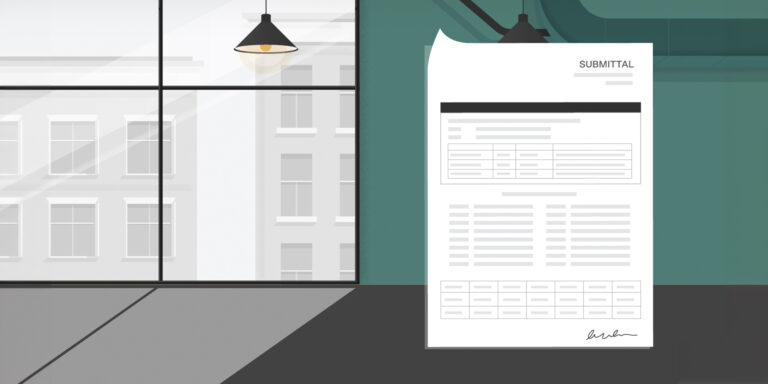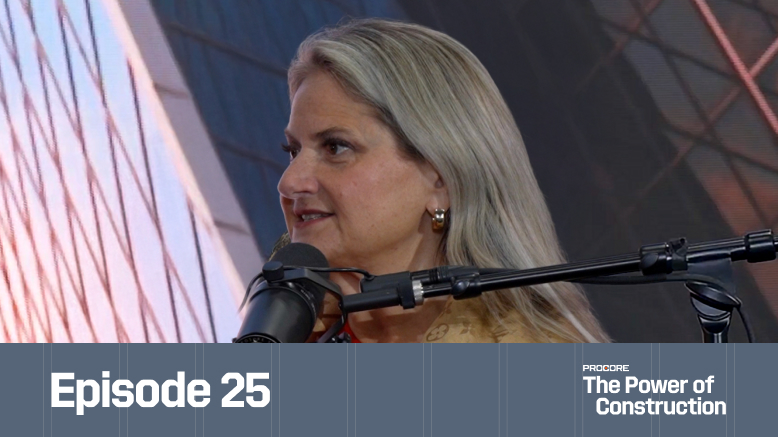— 9 min read
Working With Deferred Submittals in Construction


Last Updated Jun 11, 2025

Janine Trinidad
Staff Trainer and Program Manager
25 articles
Janine Trinidad is a Construction Educational professional for Procore Technologies. In previous roles, Janine managed all phases of construction on hotel, mixed-use, and institutional projects in the San Francisco Bay area. She was responsible for negotiating contract budgets and change orders, managing RFIs and submittals, and overseeing quality control, among other duties. She is also a certified transformational coach with a focus on women-centered and trauma-informed methods. She is passionate about transforming the construction industry to be a healthier, more successful and welcoming place to work and believes technology and education are allies in doing so.

James Hamilton
Writer & Producer
83 articles
James Hamilton is a writer based in Brooklyn, New York with experience in television, documentaries, journalism, comedy, and podcasts. His work has been featured on VICE TV and on The Moth. James was a writer and narrator for the show, VICE News Tonight, where he won an Emmy Award and was nominated for a Peabody Award.
Last Updated Jun 11, 2025

The initial designs and drawings handed to a general contractor (GC) at the beginning of a project can sometimes exclude some components: elements that still need to be designed, specifics that need to be determined or details that need to be finalized. As anxiety-inducing as that might sound, it is often on purpose and can ultimately improve a project.
Deferred submittals are parts of a project that weren’t included in the initial set of drawings and permits and are submitted at a later time. This might include specialized components, such as fire protection systems, or unique elements that require specialized design, such as a bespoke bar at a new restaurant. Understanding and having a command of the deferred submittal process can be crucial for planning, budgeting and completing complex projects.
This article explores deferred submittals, including common challenges and best practices for integrating them into the rest of a project.
Table of contents
The Basics of Deferred Submittals
By the end of the design phase, architects and engineers usually create a set of drawings and plans that will guide construction. On projects following the design-bid-build process, contractors interpret and execute plans by relying on submittals, which are documents and information shared with the design team for approval to confirm that materials, products, and equipment meet contract requirements.
Deferred submittals are the elements or components not included in the initial drawings or that need to be completed later. There are a few common reasons something becomes a deferred submittal.
Specialization
The design of certain elements require expertise that is best handled by a specialized designer. This might include fire protection systems such as sprinklers, exterior maintenance systems such as window washing equipment for high-rises, prefabricated elements such as trusses, or systems that are managed and installed by a third party, such as security cameras.
Owner preferences
Some owners want a specific contractor to design a particular component of the project. This might include custom elements at a restaurant such as a bar or kitchen equipment, unique interior finishes such as lighting fixtures or speciality architectural features, like a live greenwall or indoor pool.
Cost saving
Certain parts of the design can be outsourced to reduce the hours a design team spends on a project or because it’s possible to get a better price on them. This might include prefabricated elements such as trusses, metal framing or certain types of stairs or guardrails.
Scheduling
Components that are particularly complicated or require additional time to design or review by a specific department at an authority having jurisdiction (AHJ) are sometimes listed as deferred submittals so that the rest of the project can begin without delay.
Working With Deferred Submittals
Deferred submittals are often a way to maximize quality, meet unique challenges or improve efficiency. However, the process can complicate project management, as it usually requires the introduction of additional stakeholders, such as specialized designers and subcontractors, as well as increased coordination with the AHJ.
Most AHJs require permits for all parts of the building process. Because deferred submittals are designed after the initial set of permit drawings, they usually require applying for a permit separately and submitting plans specific to the respective component. For example, a GC might share a building’s initial set of drawings for approval by a local building authority but wait for a specialized engineer to design the fire protection systems before submitting it to the fire department.
Deferred submittals are usually included in the budget during the bidding process as allowances. An approximate amount will be included in the budget, and GCs will monitor costs as designs become finalized and work is done. If the cost exceeds the allowance, GCs will usually submit change orders to increase the budget as a change to the original contract amount.
The Deferred Submittals Process
The deferred submittal process varies depending on the nature of the component, the project, and the owner's preferences. However, it almost always involves increased collaboration and teamwork between the GC, the installing contractor, the design team, and possibly even the owner or owner’s rep. The process often follows a roughly four-step format.
Step 1: The Initial Design
While completing the initial design, also known as the permit set of drawings, the design team will identify deferred submittals by identifying items that are best specially designed or need additional time for designing or permitting. They create a list of all deferred submittals and include it in the documents passed to the GC.
Step 2: Planning And Hiring
The GC reviews the list of deferred submittals. They are specifically assessing for:
- How’s the design being paid for? Many deferred submittals are covered in the budget with allowances. In some cases, subcontractors will agree to a design-build contract or a cost-plus contract. Some owners prefer to directly pay the design-build contractor, especially when the owner has requested someone specific.
- What further collaboration is required? Some deferred submittals, such as specialized HVAC equipment, require review by the design team to ensure the element will be integrated into the rest of the plans. Others, such as window washing equipment on a high-rise, can be fully outsourced to a subcontractor. When necessary, the GC will build additional design team reviews into the schedule, typically in the form of a construction submittal review.
The GC is usually responsible for hiring and managing the subcontractor, though sometimes the design team or owner will have someone they prefer to work with and will assume responsibility for hiring and contracting. Throughout planning and construction, GCs and subcontractors will use Requests for Information (RFIs) to gather information and clarify important questions.
Step 3: Submit To AHJ
Deferred submittals often require their own permits. Many AHJs have specific processes for deferred submittals. Some places have information on their website, such as San Diego, California. The GC and subcontractor will often work together to apply for permits or will be clear about who’s assuming responsibility. Local authorities are often booked out far in advance, so it’s important to submit for permits as early as possible and proactively schedule any required interactions.
Step 4: Integration Into the Project
GCs will often continue to involve the design team to ensure the element will be fully integrated into the larger project. This might include a preliminary review of the subcontractor’s plans before submitting to the AHJ,a review after permits have been obtained, or a For Record Submittal. This collaboration helps avoid issues later in the process and ensures that all parties involved in the project are copied on significant information.
GCs are ultimately responsible for the successful completion of deferred submittal items. Many GCs will fully integrate deferred submittals into the rest of the project, by including them on the project’s submittal list and tracker for change orders. Due to their specialized nature, deferred submittals are usually flagged as high priority and treated like long lead items to ensure they receive necessary planning and coordination.
The closeout process will be the same for deferred submittal items as for other parts of the project. All necessary documents will be included with closeout documents, the final product will be reflected in as-built drawings and the work will be inspected as part of the final walk-through.
Free Course: Basics of Submittals
Master the basics of submittals with industry expert Janine Trinidad, and earn continuing education credits from AIA.

Challenges in Using Deferred Submittals
While deferred submittals can increase quality and help manage complexity, they also come with common challenges and risks.
More stakeholders
Deferred submittals usually require the addition of a specialized designer, subcontractor or both. This complicates the GC’s job, as it requires additional communication, planning and coordinating the designs from the core design team with those from the specialized designer. Having separate or multiple design teams on a project can lead to a disparity in quality and additional risks of delay. GCs should work to establish shared systems for document management, clarify tasks and responsibilities with all team members and, when possible, host preconstruction meetings that orient different team members and create clear expectations.
Questions of liability
GCs are ultimately responsible for the successful completion of a project, while the design team is ultimately responsible for creating an effective design. However, this becomes more complicated when subcontractors are designing and building specific elements. When issues arise, it can be difficult to determine who’s responsible for addressing them. Clarifying responsibilities at the beginning of the project can help to mitigate this, as well as introducing clear language around liability into contracts when possible.
Budget changes
Deferred submittals are often initially budgeted for using allowances, but these are usually rough estimates and it’s not uncommon for actual costs to exceed those amounts. GCs should establish clear systems for documenting and managing budget changes resulting from unexpected issues, scope changes and deferred submittals. Most commonly, GCs submit change orders when expenses exceed estimates. Additionally, GCs should be diligent about tracking expenses and making accounting systems transparent to all stakeholders.
Relationship management
Additional stakeholders usually means additional collaboration and communication. GCs are usually responsible for coordinating work and managing communication between different parties. Having clear systems for communicating, tools to immediately update and share drawings and having regular OAC meetings can help establish effective collaboration, decrease potential tension and catch issues as early as possible.
Clarity around responsibilities
The process of completing a deferred submittal varies based on the element and the stakeholders involved. Some owners request specific specialty contractors. Some design teams want to oversee the design of a deferred submittal themselves. Some manufacturers will only manage the design, installation and liability of their products. GCs should work to help everyone receive clarity as early as possible around who’s doing what and how their work should be delivered.
Potential delays
The design-bid-build process often pushes important conversations, including those related to deferred submittals, into the construction phase. Some equipment related to deferred submittals can be very unique and might be more difficult to procure.
Additionally, the process requires increased coordination with the AHJ. Delays should be built into the schedule and the deferred submittal process should be started as soon as possible to minimize late changes and maximize flexibility.
Document management
Deferred submittals require extensive documentation, including bids, permits, operation manuals and commissioning reports. Final as-builts should reflect all work, including work done in regard to deferred submittals. Establishing a list of required documents at the beginning of the project and having an effective system of organization can help manage the process and ensure owners receive all necessary documentation at the end of the project.
Managing Deferred Submittals: The Power of Workflows
Deferred submittals require additional stakeholders, additional documents and additional planning. Managing these variables effectively often relies on the establishment of construction workflows for the whole project. Construction workflows are processes for completing common sets of tasks, actions or project phases, such as change orders, RFIs or invoicing. Many of these systems are required for designing, planning and completing deferred submittals.
Establishing effective workflows that are repeatable, connected, transparent and collaborative for a project should help to create a framework to manage and mitigate deferred submittals as well.
Was this article helpful?
Thank you for your submission.
88%
13%
You voted that this article was . Was this a mistake? If so, change your vote
Scroll less, learn more about construction.
Subscribe to The Blueprint, Procore’s construction newsletter, to get content from industry experts delivered straight to your inbox.
By clicking this button, you agree to our Privacy Notice and Terms of Service.
Thank you!
You’re signed up to receive The Blueprint newsletter from Procore. You can unsubscribe at any time.
Categories:
Written by

Janine Trinidad
Staff Trainer and Program Manager | Procore Technologies
25 articles
Janine Trinidad is a Construction Educational professional for Procore Technologies. In previous roles, Janine managed all phases of construction on hotel, mixed-use, and institutional projects in the San Francisco Bay area. She was responsible for negotiating contract budgets and change orders, managing RFIs and submittals, and overseeing quality control, among other duties. She is also a certified transformational coach with a focus on women-centered and trauma-informed methods. She is passionate about transforming the construction industry to be a healthier, more successful and welcoming place to work and believes technology and education are allies in doing so.
View profile
James Hamilton
Writer & Producer
83 articles
James Hamilton is a writer based in Brooklyn, New York with experience in television, documentaries, journalism, comedy, and podcasts. His work has been featured on VICE TV and on The Moth. James was a writer and narrator for the show, VICE News Tonight, where he won an Emmy Award and was nominated for a Peabody Award.
View profileExplore more helpful resources

Defending Against Financial & Legal Risks on Megaprojects
The construction industry has seen marked growth in megaprojects. Some experts classify any project over $500 million as a megaproject, while others argue that the build needs to be $1...

Unlocking Project Intelligence: Moving from Raw Data to Actionable Insights
The construction industry faces a wide range of challenges, from ongoing labor shortages to frequent cost overruns. But some the biggest hurdles all stem from unpredictability. The general contractors (GCs)...

Who is accountable for innovation in construction?
Everyone says construction needs to innovate—but no one agrees on who’s actually responsible for making it happen. Is it the owner? The builders? The tech vendor? Or is innovation everyone’s...

Integrated Project Delivery in Practice: A Framework for Collaboration
On construction projects, traditional delivery methods put different stakeholders in their own silos. While the design team feeds drawings and specifications to the general contractor (GC), the GC’s expertise in...
Free Tools
Calculators
Use our calculators to estimate the cost of construction materials for your next project.
Templates
Find a template to help you with your construction project tasks.
Material Price Tracker
Get the latest U.S. retail prices and view historical trends for common building materials.
Glossary
Explore key terms and phrases used in the industry.
